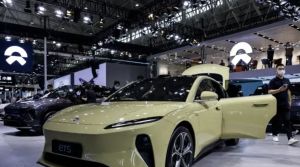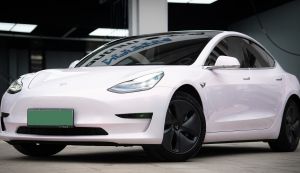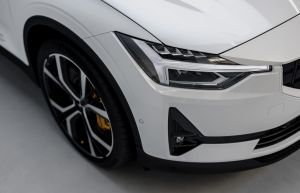Test Owner
The French government has established a comprehensive agreement with the automotive industry to set new targets for electric vehicle (EV) sales. This pact, developed in collaboration with French business groups and unions, aims for significant increases in the sales of battery-electric cars and light commercial vehicles by 2027.
The agreement targets a fourfold increase in annual battery-electric car sales to 800,000 and a sixfold increase in electric light commercial vehicle sales to 100,000. While the pact does not specify exact amounts for new subsidies, it promises continued support for EV purchases and leases. Additionally, the contract includes a section on "ensuring our sovereignty," which involves stress testing supply chains for critical materials.
This new "strategic sector contract" is introduced as France and other countries raise concerns about the risk of over-capacity in China's EV market overwhelming their domestic industries. The European Commission has responded to these concerns by launching an investigation into China's support for its EV sector.
"The auto industry is part of our industrial culture and is facing a once-in-a-century change," said French Finance Minister Bruno Le Maire. "The transition is difficult, with strong competition from other countries, particularly China, so we need solidarity in the sector."
To counter the influx of Chinese imports, France has restricted financial support for EV purchases to vehicles with the lowest carbon footprint in production, effectively excluding many Chinese-made models. France is also the first country to use new European rules to support its emerging battery industry with green tax credits.
"Europe must adopt a trade policy that protects our industry, our jobs, and our technology," Le Maire said. "I decided to limit bonuses for EVs to cars that meet the strictest environmental norms, to enhance our production and confront increasingly tough competition."
The wide-ranging agreement also includes a framework for cooperation on innovation, retraining, strengthening the sector’s supply chain in France, and expanding the network of recharging stations.
The pact coincides with Chinese President Xi Jinping's state visit to France, during which EU-China tensions over EVs were expected to be a key issue. These tensions have escalated into a broader conflict, with Beijing launching a liquor dumping probe that could adversely affect French cognac producers.
Shares of Nio Inc., a prominent Chinese electric vehicle manufacturer, surged by 20% on Thursday following news of a significant increase in vehicle deliveries for the month of April. The company's Hong Kong-listed shares soared by as much as 23% to reach 44.20 Hong Kong dollars, marking their highest level in over six weeks. Nio's robust performance also contributed to a 2% increase in the broader Hang Seng index during midday trading.
Nio reported a remarkable year-on-year increase of 134.6% in vehicle deliveries for April, with a total of 15,620 vehicles delivered. The delivery breakdown included 8,817 premium smart electric SUVs and 6,803 premium smart electric sedans, as stated in the company's statement released on Wednesday. So far this year, Nio has delivered 45,673 vehicles, representing a 21.2% increase compared to the same period last year.
In addition to bolstering its vehicle deliveries, Nio has been actively expanding its battery swap partnerships, aiming to enhance the infrastructure aspect of the electric vehicle ecosystem. These efforts are geared towards alleviating consumer concerns regarding driving range limitations.
Other major Chinese electric vehicle manufacturers, including Li Auto, Xpeng, and BYD, also reported their April deliveries on Wednesday. Li Auto delivered 25,787 vehicles in April, experiencing an 11% decline compared to March. Meanwhile, Xpeng reported a 4% increase in April deliveries, totaling 9,393 EVs. BYD's sales volume for EVs in April reached 313,245 units, marking a 3.6% increase from March.
Amidst escalating competition in the Chinese electric vehicle market, manufacturers have engaged in a price war, particularly with U.S. automaker Tesla. Various EV makers have slashed prices as they strive to outperform Tesla by offering advanced technology and competitive pricing strategies. Tesla recently reduced the starting price of its Model 3 in China and other key markets, prompting similar moves from competitors like Li Auto.
The intensifying competition saw Chinese smartphone giant Xiaomi entering the electric vehicle market in early April with the launch of its SU7 electric car. Priced approximately $4,000 lower than Tesla's Model 3, Xiaomi aims to capture market share by offering a longer driving range. Despite selling its new EV at a lower price point, Xiaomi's CEO Lei Jun expressed optimism about the vehicle's sales performance, indicating a potential to achieve profitability sooner than expected.
Chinese automotive giant BYD has reported a significant decrease in profits, attributing it to reduced demand for electric vehicles (EVs) and intensified competition in the global automotive landscape. The company disclosed that it generated $630 million (£502 million) in the first quarter of the year, marking a notable drop of over 47% compared to the preceding quarter.
As BYD vies with Elon Musk's Tesla for dominance in the EV market, it has encountered challenges in maintaining its position as the world's leading EV seller. Despite briefly surpassing Tesla in sales at the end of last year, the US-based Tesla reclaimed the top spot earlier this month.
BYD's sales of battery-only cars totaled just over 300,000 units in the first quarter, a decrease from the record-breaking 526,000 units sold in the final quarter of 2023. The company's latest financial results indicate a potentially more favorable performance compared to Tesla, which recently reported its first quarterly revenue decline since the onset of the pandemic in 2020.
Amidst a price war among EV manufacturers in China, BYD and its competitors are grappling for market share amid a backdrop of slower economic growth. To stimulate demand, BYD has implemented price reductions on select models, aiming to attract buyers who exhibit greater caution in making substantial purchases like cars.
In response to softer demand within China, BYD has embarked on an expansion into new international markets. The company exported 240,000 vehicles in 2023 and anticipates a significant increase in exports this year. However, its aggressive expansion strategy has triggered concerns in the US and Europe, where governments are inclined to safeguard the interests of domestic automakers.
In addition to bolstering its export initiatives, BYD has diversified its product portfolio by introducing higher-end models. At the Beijing auto show, the company showcased its latest luxury vehicles, underscoring its commitment to innovation and market expansion despite prevailing challenges in the EV sector.
China's largest auto show kicked off in Beijing on Thursday with a dazzling display of the latest electric vehicles (EVs) from top automakers, underscoring the nation's position as the world's largest electric vehicle market.
Automakers are gearing up to reveal 117 new models, a notable increase from last year's 93 showcased in Shanghai. Organizers reported a total of 278 new energy vehicles (NEVs) set to debut, seven more than the previous year. This surge in innovation comes as NEV sales reached a milestone in early April, constituting over 50% of car sales in China, according to auto association data.
The industry has witnessed a fierce price war over the past year, driving down profit margins as automakers vie to introduce newer, more affordable models and enticing promotions.
"At the Beijing auto show, there's no denying the waning interest in gasoline vehicles. Everyone is seeking the latest advancements in intelligence and electrification," remarked William Li, founder and CEO of Chinese EV maker Nio (9866.HK), speaking to Reuters. "If you attend, there's no question about EVs anymore. It's not just the future; it's the present."
Chinese manufacturers like BYD (002594.SZ) and newcomer Xiaomi (1810.HK) attracted crowds, with Xiaomi stealing the spotlight by hosting one of the earliest press events. Xiaomi CEO Lei Jun revealed impressive pre-orders for its SU7 sedan, including buyers who previously owned vehicles from BMW (BMWG.DE) and Audi. BYD, the world's largest EV maker, showcased its premium brands Yangwang and Denza in a bid to shift its image from a budget automaker.
Foreign automakers, eager to realign their strategies with China's electric shift, announced plans to bolster local production and research. Nissan Motor (7201.T) and Mazda Motor (7261.T) from Japan unveiled models tailored for Chinese drivers, while General Motors (GM.N) excluded traditional engine vehicles from its lineup for the first time. Mercedes Benz (MBGn.DE) dismissed rumors of abandoning electrification as it unveiled a lineup of new EVs.
Tesla (TSLA.O) notably skipped the show again, following an incident in 2021 where a disgruntled customer protested atop a displayed Tesla over brake complaints.
Chinese brands outlined ambitious overseas plans, emphasizing innovation amid concerns of industry overcapacity in Europe and the U.S.
"As the Chinese automotive industry enters a new era of globalization and domestic brands gain strength, the emergence of Chinese vehicles on the world stage is a growing trend," noted Great Wall Motor (601633.SS) President Mu Feng.
Smart driving technologies took center stage, with domestically developed advanced driving assistance systems rivaling Tesla's Full Self-Driving (FSD). Companies like Seres (601127.SS) and Guangzhou Automobile Group (GAC) (601238.SS) showcased systems supplied by Huawei Technologies (HWT.UL), while others like BYD and XPeng (9868.HK) touted in-house developed features.
BYD announced plans to launch revamped models equipped with its self-developed advanced driving assistance system (ADAS), while XPeng pledged to continuously upgrade software to maintain a competitive edge.
GAC revealed intentions to introduce flagship models with Huawei's ADAS from January 2025, one of several state-owned automakers partnering with Huawei to leverage its technology.
"Huawei leads in advanced assistance driving capabilities," stated GAC General Manager Feng Xingya. "We are committed to ensuring that GAC products offer the most advanced technologies to consumers."
Great Wall Motor's Global Odyssey: Navigating Challenges Towards Ambitious Overseas Sales Goals
Great Wall Motor is setting its sights on the global stage, aiming to surpass 1 million units in overseas sales by 2030, with a significant portion being premium models, according to an announcement made on its official WeChat account. This new target marks a shift from its previous goal outlined in October last year, where the company aimed for annual overseas sales of 1 million units by 2025, including 400,000 units produced locally abroad.
With 27 years of experience pioneering overseas markets, Great Wall Motor is ramping up its investment efforts abroad, integrating its research and development, production, supply, sales, and service systems under its single brand umbrella. The automaker boasts a widespread presence, having exported vehicles to over 170 countries and regions, with a network of more than 1,000 sales outlets worldwide.
Despite its ambitious plans and solid global footing, Great Wall Motor's trajectory has faced delays, particularly amidst a challenging market landscape. This includes an anti-subsidy investigation initiated by the European Commission into imports of battery electric vehicles from China, a move that prompted Great Wall Motor to respond swiftly and strategically, including the establishment of a European R&D center.
Notably, Great Wall Motor's vice president and head of overseas business, Shi Qingke, reiterated the company's commitment to achieving the 1 million annual sales target by 2025, with a substantial portion of those units being locally manufactured abroad. In 2023, Great Wall Motor recorded impressive sales figures, totaling over 1.2 million vehicles, with overseas sales surging by over 82%, contributing significantly to its overall performance.
As Great Wall Motor navigates the complexities of global markets, its revised timeline underscores a pragmatic approach to ensure sustainable growth and continued success on the international stage.
"Parliamentary Milestone: Germany Votes to Streamline Citizenship Procedures and Embrace Dual Nationality"
The German parliament has granted approval for legislation aimed at facilitating the acquisition of citizenship and removing restrictions on holding dual citizenship last friday. The proposal, advocated by Chancellor Olaf Scholz's center-left, socially liberal coalition, garnered a majority vote of 382-234, with 23 lawmakers abstaining. While the government contends that the move will enhance immigrant integration and attract skilled labor, the main center-right opposition criticizes it, asserting that it could devalue German citizenship.
The approved legislation reduces the residency requirement for citizenship eligibility from eight to five years, or three years in the case of "special integration accomplishments." German-born children automatically become citizens if one parent has been a legal resident for five years, down from the current eight years. Additionally, the law eliminates restrictions on dual citizenship, a departure from the existing requirement that individuals from countries outside the European Union and Switzerland relinquish their previous nationality upon gaining German citizenship.
The government notes that 14 percent of the population, over 12 million out of 84.4 million inhabitants, lacks German citizenship, with around 5.3 million having resided in Germany for at least a decade. Germany's naturalization rate is reportedly below the EU average. In 2022, 168,500 people were granted German citizenship, the highest figure since 2002, with a notable increase in Syrian citizens being naturalized.
Interior Minister Nancy Faeser emphasizes that the reform aligns Germany with European neighbors like France and aims to attract skilled workers. The legislation specifies that those seeking naturalization must be able to support themselves and their dependents, with exceptions for "guest workers" who came to West Germany before 1974 and those who arrived in communist East Germany to work.
The existing requirement for citizenship applicants to adhere to the "free democratic fundamental order" is retained, with the new version explicitly stating that antisemitic and racist acts are incompatible with this commitment. However, the conservative opposition argues that Germany is relaxing citizenship requirements at a time when other countries are tightening theirs, describing the legislation as a "citizenship devaluation bill."
The citizenship law overhaul is part of a broader series of social reforms agreed upon by Scholz's three-party coalition upon taking office in late 2021.
China has emerged as a formidable player in the global electric vehicle (EV) market, and the recent unveiling of Xiaomi Corp.'s first electric vehicle, the SU7, is a testament to the nation's ambitious strides in automotive innovation. Xiaomi's entry into the EV arena, targeting industry giants like Tesla Inc. and Porsche AG, signals a new chapter in the competitive landscape of China's burgeoning electric vehicle sector.
At a grand event hosted at the China National Convention Center, Xiaomi's co-founder and CEO, Lei Jun, proudly introduced the SU7, a five-seat sedan designed to rival luxury car brands. The SU7 boasts an impressive 800-kilometer range per charge, adjustable spoilers, a top speed of 265 kilometers per hour, and a unique array of colors. Xiaomi plans to collaborate with renowned Chinese battery manufacturers, Contemporary Amperex Technology Co. Ltd. and BYD Co., offering consumers single and dual motor configuration options.
Lei Jun's foray into the EV market is backed by a substantial $10 billion investment, aligning with Xiaomi's disruptive impact in the smartphone industry. The SU7, positioned alongside Porsche's Taycan Turbo and Tesla's Model S in terms of performance and technology, is expected to be competitively priced, although the exact figures are yet to be disclosed.
While Xiaomi aims to revolutionize the EV market, it faces challenges in China's evolving regulatory landscape. Constraints such as manufacturing permit limitations prompted Xiaomi to form a partnership with Beijing Automotive Group Co. for EV production. The discontinuation of significant state EV subsidies in 2022 adds another layer of complexity to Xiaomi's entry into the competitive market.
Lei Jun remains undeterred, positioning the SU7 as a viable alternative to higher-priced competitors. Addressing market speculation about the SU7's price, Lei hinted that it would surpass the rumored 99,000 yuan, aligning more closely with higher-end models often priced over 400,000 yuan.
Xiaomi's venture into the electric vehicle market adds a new dimension to China's rapidly evolving automotive landscape. With the SU7's impressive features and Lei Jun's ambitious vision, Xiaomi aims to disrupt the status quo and compete with established players on both the domestic and global fronts. As China continues to assert itself as a key player in the electric vehicle revolution, Xiaomi's SU7 promises to be a pivotal contender, embodying the nation's commitment to driving innovation and sustainability in the automotive sector.
China's commitment to EVs remains evident as the country leads global sales, experiencing a 29% increase in EV sales year-to-date as of September. Xiaomi's entry into the EV market aligns with broader trends, reflecting China's dedication to sustainable transportation.
"MATLAB EXPO U.K.: Unveiling the Evolving Landscape of Embedded Systems with MathWorks Products"
The annual MATLAB EXPO U.K. event attracted 600 delegates this year, offering a platform for users to delve into the latest advancements. The focus of the event spanned networking, technical presentations, and shared experiences covering various technology and science domains, including AI, telecommunications, autonomous systems, robotics, and electrification.
Richard Rovner, VP of Marketing at MathWorks in Natick, Massachusetts, emphasized the significance of MATLAB EXPO in user communication. He pointed out the challenge users face in keeping up with over 130 software products and biannual releases. Despite the wealth of information available on MathWorks' website and through regular digital communications, Rovner highlighted the dedicated and focused nature of the event, providing users with the opportunity to stay abreast of new capabilities and learn from each other.
In a discussion about the increasing complexity of embedded systems, Rovner acknowledged the two-decade growth in complexity across various applications, such as aero, auto, and industrial automation. He emphasized the integration of software into the early stages of the design process, making software design an integral part of the entire workflow.
To illustrate the complexity of embedded systems, Rovner shared an example of an intelligent sensor application incorporating AI. He highlighted the need to select the correct algorithm, plan algorithm training and testing, consider embedded design, deployment to the network, and address trends like digital twins and autonomous operation. Rovner emphasized the relevance of adopting a model-based design perspective, offering a platform that accelerates the development of similar devices.
Jos Martin, Director of Engineering at MathWorks, contributed insights into the evolving nature of system complexity. He noted that what was considered simple two decades ago is now significantly more intricate. Martin emphasized the substantial increase in lines of code, from 30,000 to two million, in contemporary systems. He explained why startups opt for MathWorks products from the outset, citing the necessity for rapid, cost-effective development of complex systems to create valuable products.
Martin also discussed the changing approach to system design, driven partly by necessity. With the market pushing for innovative uses of embedded hardware, complexity has become intrinsic due to the abundance of computational resources available in modern hardware.
Highlighting the importance of productivity, Martin suggested that both large and small organizations should prioritize efficiency. He shared an example of a one-person development organization realizing increased productivity through the use of system-level design tools. Martin advocated for a system model approach, using toolchains to enhance effectiveness and focusing on higher-level design concepts to improve productivity and produce higher-quality designs.
Rovner concluded by advising engineers and developers to consider modeling and simulation tools when designing engineered products. He emphasized that this approach accelerates the transition from prototype to product, reduces costs, and minimizes errors by identifying bugs early in the design process.
The adoption of new technologies plays a pivotal role in business transformation, enhancing productivity and profitability. Gartner has identified five key technologies that businesses should consider incorporating to enrich their operational capabilities.
Here are the five technologies identified by Gartner:
- The Digital Human: While generative AI isn't at the top of the list, the concept of the digital human, a subset of generative AI, takes the spotlight. Digital humans are AI creations that embody real individuals in various aspects, such as personality, appearance, humor, and knowledge. Many companies have adopted digital humans to boost engagement and address the growing interest in AI. However, Gartner cautions against inappropriate behaviors like biases and stereotypes that may arise, emphasizing the need to establish rules.
- Satellite Communications: This technology, exemplified by SpaceX's Starlink, offers low-latency connectivity from low Earth orbit satellites. Satellite communications are garnering increasing interest as they have the potential to revolutionize communication between individuals and businesses. However, Gartner highlights that this emerging industry requires a cautious approach due to its complexity.
- Miniature and Ambient IoT (Internet of Things): This variant of the Internet of Things (IoT) enables tracking and object detection without the need for batteries. This opens the door to more extensive information collection at a lower cost, with the potential to create new ecosystems, business models, and innovative products. However, Gartner warns that social and regulatory issues must be considered before adopting this technology.
- Secure Computation: In a world where data protection is of paramount importance, secure computation allows for calculations while preserving the confidentiality of information. Gartner underscores that implementing secure computing poses challenges in terms of costs, skills, and performance, but emerging technologies such as optical accelerators will play a key role in its realization.
- Autonomous Robots: Autonomous robots, capable of operating with minimal human intervention and adapting to different environments, offer a wide range of business applications. They can perform tasks such as object lifting, surveillance, and data collection. However, Gartner highlights the many challenges associated with these technologies, including limitations in their capabilities and business, legal, and ethical implications.
These five technologies are considered potential drivers of transformation, offering businesses new opportunities and significant advantages. However, their adoption requires careful evaluation and consideration of the various issues associated with each of them.
As the demand for generative AI technology continues to rise, industry giants, including Microsoft, Google, AWS, and OpenAI, are exploring the development of their own custom chips tailored for AI workloads. Contrary to popular belief, the primary driver behind this push isn't chip shortages but rather a strategic shift toward optimizing the efficiency and cost-effectiveness of processing generative AI queries.
Speculation has swirled around efforts by OpenAI and Microsoft to develop custom chips for handling generative AI tasks, with Microsoft collaborating with AMD on a project codenamed Athena and OpenAI rumored to be eyeing potential acquisitions to bolster its chip-design capabilities. In the meantime, Google and AWS have already introduced their own chips for AI workloads in the form of Tensor Processing Units (TPUs) for Google and AWS' Trainium and Inferentia chips.
So, what's motivating these companies to delve into custom chip development? Analysts and experts point to two key factors: the cost of processing generative AI queries and the efficiency of existing chips, primarily Graphics Processing Units (GPUs). Currently, Nvidia's A100 and H100 GPUs dominate the AI chip market, but their efficiency in handling generative AI workloads is under scrutiny.
Nina Turner, a research manager at IDC, notes that GPUs may not be the most efficient processors for generative AI tasks, and creating custom silicon could potentially address this efficiency issue. GPUs, while highly effective for matrix inversion, a fundamental mathematical process in AI, are costly to operate. The pursuit of silicon processors optimized for specific AI workloads could help alleviate cost-related concerns.
Custom silicon, according to Turner, has the potential to reduce power consumption, improve compute interconnectivity, and enhance memory access, ultimately lowering query costs. For instance, OpenAI's operation cost for ChatGPT is roughly $694,444 per day, which translates to 36 cents per query, based on a report from research firm SemiAnalysis.
Furthermore, custom silicon provides the advantage of exerting control over chip access and designing elements tailored specifically for large language models (LLMs), thereby enhancing query speed.
This shift towards custom chip design is likened to Apple's approach to producing chips for its devices, where specialization trumps general-purpose processors. Despite the popularity of Nvidia's GPUs, they, too, are considered general-purpose devices. Custom chips could be the answer to optimizing performance for specific functions, such as image processing and specialized generative AI.
However, experts caution that developing custom chips is no easy feat. It involves significant challenges, including high investment requirements, lengthy design and development timelines, complex supply chain issues, a scarcity of talent, and the need for a sufficient volume of production to justify the expenditure.
For companies embarking on this journey from scratch, the process can take a minimum of two to two and a half years, with the scarcity of chip design talent causing delays. Several large tech companies have mitigated this challenge by either acquiring startups with expertise in chip development or partnering with experienced firms in the field.
Despite ongoing discussions about chip shortages, experts believe that the move towards custom chip development by companies like OpenAI and Microsoft is more about addressing inference workloads for LLMs, particularly as Microsoft continues to incorporate AI features into its applications. It appears that these companies have specific requirements that aren't met by existing solutions, and a specialized chip for inference workloads, which is more cost-effective and efficient than large GPUs, may be the solution.
Acquiring a major chip designer may not be a cost-effective approach for OpenAI, given the substantial expenses involved in designing and producing custom chips. Instead, experts suggest that OpenAI could explore the acquisition of startups with AI accelerators, a more economically viable option.
To support inferencing workloads, potential acquisition targets could include Silicon Valley firms like Groq, Esperanto Technologies, Tenstorrent, and Neureality. Additionally, SambaNova might be a suitable candidate if OpenAI is willing to transition away from Nvidia GPUs and adopt an on-premises approach, moving beyond a cloud-only paradigm.














